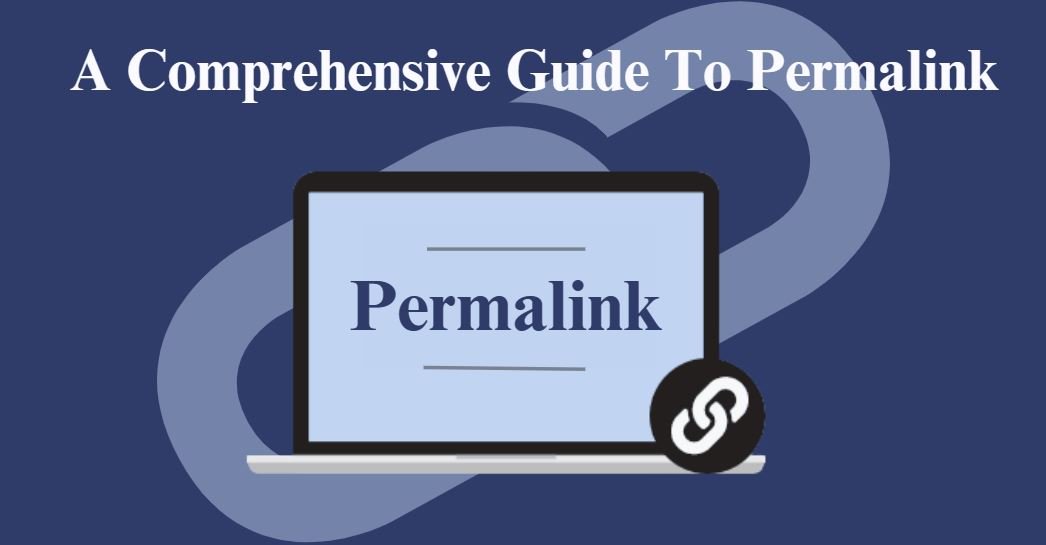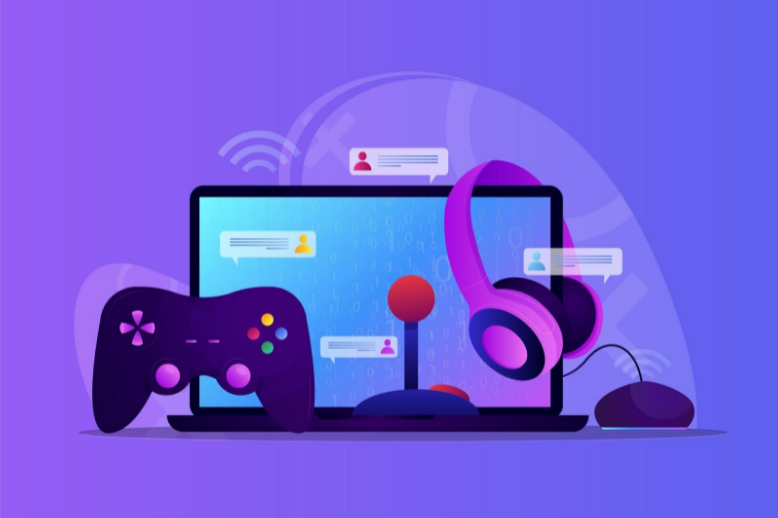Once you’ve got users on your site and engaged, the next thing to worry about is user retention. ‘User retention’ refers to the proportion of customers who come back to your site and use your product on a regular basis. The main driver of good retention is good product/market fit but having an awesome product that actually solves people’s problems isn’t enough to ensure growth. Here are a few tactics you can use to make sure people keep coming back.
1. Funnels
As with other steps in the growth hacking funnel, paying attention to analytics is crucial when it comes to retention. Your actions should not simply be based on what you have read or what competition is doing, but primarily on your data analysis. Don’t stop at log in statistics – that won’t show you what your existing users do after logging in. Create funnels that show you which features customers use, which they ignore and where the drop off points are. Make sure your funnels are accurate and keep them as clear as possible to make it easier to identify and use the necessary information. Finding out exactly what users do with your product is the first step toward a good retention strategy.
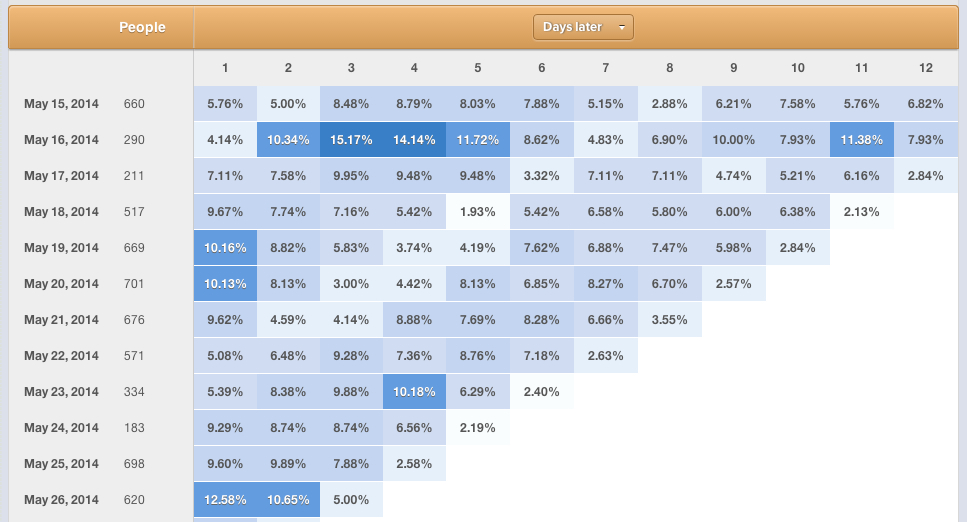
www.mixpanel.com
2. Where is your Aha! moment?
You all know the story of Twitter and how they found that users who follow more than 5-10 people are more likely to come back and start using Twitter regularly. That’s exactly the kind of knowledge you need. Define your Aha! moment, dig deep into your analytics and find out what makes people come back and use your product. Ask your customers when the Aha! moment happened for them, and use it. You can extend some features, make some more visible to users, and you can direct first time visitors to the crucial point or, like Twitter, force them to take a certain step. You should constantly be trying to make the user experience easier.

3. Good old e-mail
Newsletters may seem irritating for some users, but there is a good reason they are still the most popular way of keeping in touch with people who have signed up. They are a cheap and easy way of letting people know about changes or improvements to your product, but also a great way of reminding people that you exist. It’s surprisingly easy for people to forget about what they’ve signed up for, even if they were excited about it at the time – there are a lot of diversions out there. Good e-mail newsletters do not have to be spammy or annoying. Before sending anything, make sure it represents real value to the intended reader, like a great article, new feature update (value here is discussable) or a weekly digest of user-generated content. Interesting e-mails, that users actually read, will help you bring customers back to your website and keep them engaged. This is also a great opportunity to test your newsletters content, headlines and sending frequency, until you achieve the best possible effects.
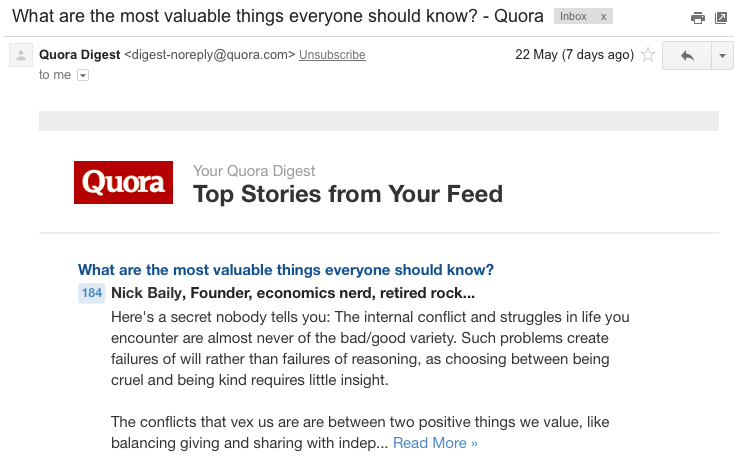
Quora email digest
4. Drip campaigns
An e-mail newsletter is a great first step to engaging with your users, but you can also guide them through your transactional funnel by creating drip campaigns. Sending relevant messages, tailored to users’ specific interactions with your product and previous e-mails can be used to nurture your leads and to re-engage users who have stopped using your product. These messages can be triggered by specific actions and also personalized for different user segments. Done right, a drip campaign can help direct your customers to the bottom of the funnel and prepare them for transaction.

www.pardot.com
5. More than just a product
Don’t just focus on your product. Think about who your customers are, what they care about, and where they hang out. Embracing and engaging with your customers means understanding them, their needs and desires. Once you understand these, you can connect them to your product by creating interesting and valuable content that is helpful and attractive. Give your customers more than just your product – give them something important and useful to show that you understand them and their needs. You can also consider creating special content or features for your most engaged users. The goal is to become part of your customers’ everyday lives, not just a company at the other end of a financial transaction. Content marketing is great not only for user acquisition. Check out how KISSmetrics does a good job.

www.blog.kissmetrics.com
6. Make it annual
Getting your monthly paying customers to switch to an annual plan is the best way to keep your churn figure low and your cash flow healthy. Unfortunately, people are often reluctant to make long-term commitments and are highly unlikely to sign up to an annual plan if there’s nothing extra in it for them. This is why most companies have promotional offers for upgrading from a monthly to an annual plan, such as 20% off, a month for free, or extra features and gifts. Offer the best you can to users who choose the annual option and make sure it’s really clear in your pricing how much they are saving. To help convince monthly users to upgrade, send them an e-mail with information about your annual discounts near the end of their first month.

www.blinkist.com
7. Survey forms
Increase your retention rate by simply improving your offer. How to do it? Your existing customers are probably the best source of information about your product. If you want to improve, it is wise to know what they think. Create short, simple survey forms with no more than 2 or 3 questions and push them to users who come back to your product. You can ask if there is anything they would like to change, anything bugging them, or something they would like to see added. Users generally don’t like surveys, so it’s really important not to overwhelm them with questions. To avoid doing more damage than good, don’t ask too early, before a customer is truly engaged, don’t ask too many questions at once, and don’t ask too often. You can also A/B test your surveys to see if your customers prefer open-ended or yes-no questions and what kind of questions get the most answers.

www.qualarooo.com
8. Changes
Keeping your users interested is not easy if your product isn’t developing and offering new features. The surveys and direct contacts discussed in the previous entry are a good way of finding out what customers need or are looking for. It’s easy to overlook new features, especially if someone is used to the product and using it in a certain way. To make sure users notice improvements, ask them to try them out and give you feedback. You could make it exclusive for most active users to test new features, they will definitely feel special when you ask them. No product can survive without adjusting to a changing world and the evolution of users’ needs. The biggest players, like Facebook and Twitter, are always changing, fixing and improving their features based on thorough analysis of users’ experience and behaviour.

www.twitter.com
9. Amazing customer support
Caring for your customers is one of the best ways to ensure they come back, and tell other people about you. It’s a pure benefit for you and your customers. Everyone likes to feel important and taken care of, so your customer support should have this goal. When users need help, answer them immediately, or create event-based e-mails to give them the information even before they ask for help. Always remember that B2B or B2C actually means human to human – show your customers that you are a real person and that you regard them as real people too. Don’t be too formal, recognize opportunities to personalize their experience but always be sincere about it. How? Look to Zappos as an example – they’re famous for outstanding customer support.

www.helpscout.com
10. Inactive users
Don’t assume that users who aren’t active have ditched you forever. We use so many applications on a daily basis that it’s really easy to forget about some, even great ones. Maybe that’s what happened to your product. Maybe the user didn’t understand it well enough. Maybe they got bored of it or it just wasn’t the right fit at the time. This doesn’t mean that inactive users are lost forever. They may still be interested in your product, but need reminding about it, or they might be swayed by offering them something more than when they last used it. Releasing new features is great opportunity to do this. Contact these drop outs by e-mail or make a phone call if possible to ask why they stopped using your product. Most people will appreciate the personal touch and feel your company genuinely values them.
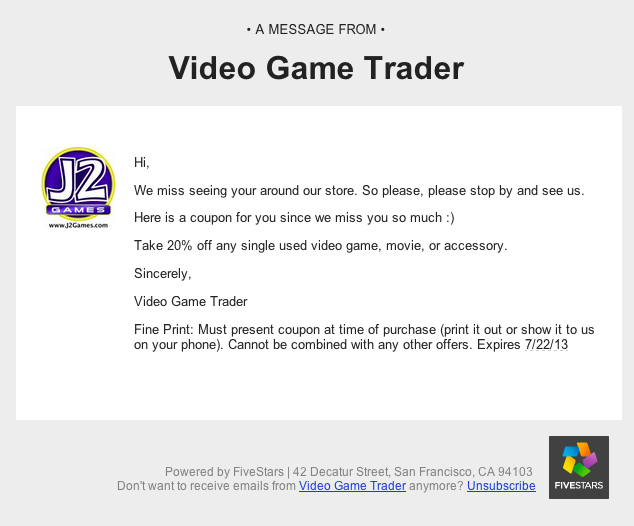
www.fivestars.com
11. Exit surveys
You can’t keep every customer forever. Inevitably, some will leave you, stop using your product and cancel their subscriptions. Treat this as an opportunity to find out how to stop others people from leaving. In some cases, you might even convince a customer to stay by offering freebies or a new, improved package. Even if that doesn’t work, make full use of the opportunity to learn as much as possible. Ask unsubscribing customers why they are leaving, what they felt was missing from your product or what could be improved. Use this information to improve your product. Why not make it fun? Hubspot are a great example of a company who did this right by creating an awesome message for unsubscribing customers. Could you really leave after watching this?
12. Remarketing
The idea of remarketing is to make people who have already visited your website come back, and it’s the most popular way of increasing retention. It can be really effective and is cheaper than regular ads because it is only displayed to people who already visited. This also provides an opportunity for a customized message. By adding a remarketing pixel to certain subpages, you can personalize your ads depending on what users saw or did on your website. This allows you to inform existing customers about items of interest, such as extra features, industry conferences or your other products.

www.where2getit.com
13. Community
A great way to keep your customers and users within easy reach for communication is to create a place where they can hang out and feel good. One way to do this is to create an ecosystem around your industry and encourage the community to make it lively. For inspiration, check out inbound.org, created by HubSpot and Moz. It’s a useful platform where marketers can share articles, do AMAs and so on. Although the place itself is not branded, the HubSpot and Moz brands appear often and in a very natural way. Another way to facilitate a community is to do it the Yelp way. This is the next level in social interaction, and works out pretty well for them by engaging users in a lot of real-world events and meet-ups where they build genuine personal relationships that are then continued online.

www.inbound.org
14. Gamification
Rivalry is a great motivating factor, which is why the best online businesses have learned to harness it. Collecting points, chasing people in rankings and contributing to common results keep users engaged. LinkedIn, for example, have done a great job of implementing endorsements, which has encouraged members to interact with each other more. The system also means that a member who puts in the time and effort to gather a lot of endorsements is much less likely to abandon the platform. There are plenty of other examples: mayorships on Foursquare, progress tracking and badges on Codeacademy and status earning on Moz blog.

Foursquare
15. Appreciating your users
It’s a no brainer that good relations with your customers will increase retention rate. One of the best ways to achieve this is to reach out to them personally. In the early stage, this is relatively easy because your customer base probably isn’t very big. This is a good thing, because it means even senior team members, like the CEO, can find the time to contact customers in person. Later on, as your business gets bigger, you might have to choose only the most engaged users to reach out to. Even the simplest e-mail (from your personal address, not mass mailing) can work miracles, but if you want to get more creative, you can think about sending out t-shirts or even cakes.

Mixpanel mailing
16. Twitter shout-outs
Even if your product is awesome, there is no guarantee that people will use it all the time. Sometimes it’s just a matter of bad timing, sometimes because other priorities crop up, and sometimes people simply get distracted by novelties and forget about your product. One of the easiest ways to ensure your customers don’t forget about you is to be present and engaging in their social media life. The best tool for making the relationship personal is probably Twitter, because it allows super-easy interactions in the brand-customer line. There is nothing stopping you from mentioning individual customers in your official profile, saying ‘hi’ or simply retweeting their messages. The trick is to pick the right individuals. For this, you could trade something valuable (extra content, additional functionality etc) for a Twitter follow. The rest is up to you, but something is always better than nothing when it comes to reminding people that you exist.

17. Statistics
People like to see progress and be a part of it. This also applies to online products and services. You can take advantage of this aspect of human psychology by giving people a way to track progress. How? One of the easiest methods is to show them numbers and graphs. Make it easily digestible and easy to remember and share. If you provide some kind of a business service, think how a person could share that data with his boss (or the other way around). If your data is relevant and provides value, it could become an internal performance indicator in day-to-day work. This places you directly in your customer’s attention every day! Look at Slideshare or Twitter, they provide numbers that marketers look at and track every day because it shows how well they are performing. The same applies to a B2C end user – let him track the numbers and help him make it a habit. Isn’t it compelling tracking visits to your LinkedIn profile, or the most listened to songs on Last.fm, or video plays on YouTube? Think you don’t have any interesting statistics to offer? Look for something you track internally to find some inspiration.

www.linkedin.com
18. Side products
Most successful companies do not offer stand-alone products, they offer an entire ecosystem comprised of supplemental services. I know you probably don’t run Google or Apple, but those are excellent role models to follow. Additional, non-core products can help you become a more important part of your users’ ecosystem. Think what kind of tools and services your customers would find useful, then build it for them! Once you have it, promote it under a different brand, so people don’t confuse it with your core product (Btw, this can also help you reach new people through unexplored channels). You can then find a way to integrate the new product with your core offering, tying your users even closer. I like the way HubSpot did this with Signals – check it out.

www.getsignals.com
19. Browser widgets
Constant refinement and evolution are essential to user retention. As well as adding new functionalities that extend your product, think about functionalities that make your product easy to find. One idea worth considering is creating a browser widget/extension. This kind of feature allows customers to interact with your product more easily and helps turn it into a habit. This tactic is not applicable in every case, but a bit of creativity can have surprising results. Multiple examples prove that add-ons work for products were you wouldn’t expect them to. If 9gag.com, a site offering funny pictures, can make it work, why can’t it work for your company? Buffer is an excellent example – their extension lets users share articles flawlessly straight from other people’s sites.
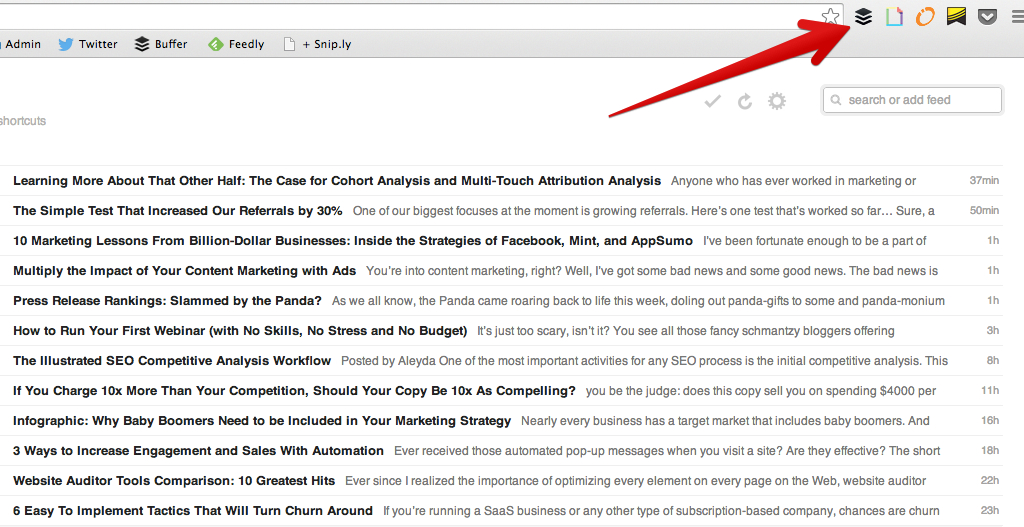
20. API integrations
Integrating with other products is a great route to user acquisition, but it can also help with retention. Users are more likely to stay with your service if you provide them with maximum comfort. When you connect your product to others that are also used by your customers, their life becomes a little easier and they feel more comfortable. Don’t know what or who to integrate with? Ask your customers. Then make sure your product is listed on Zapier or IFTTT.
www.zapier.com
21. No overpromising
It’s tempting to make big promises to encourage visitors to click the sign-up button, but never promise more than you are absolutely sure you can deliver in a reasonable time frame. You’re better off not mentioning features or benefits that are not yet quite ready rather than promising to revolutionize visitors’ lives tomorrow. When that killer new feature is ready, you can surprise them positively, rather than letting them down by over-promising. Users are far more likely to stay with you and refer your products to their friends if you make them feel good. That’s won’t happen if you over-promise and under-deliver. Work on your copy to make sure expectations are at the right level before clients activate.





